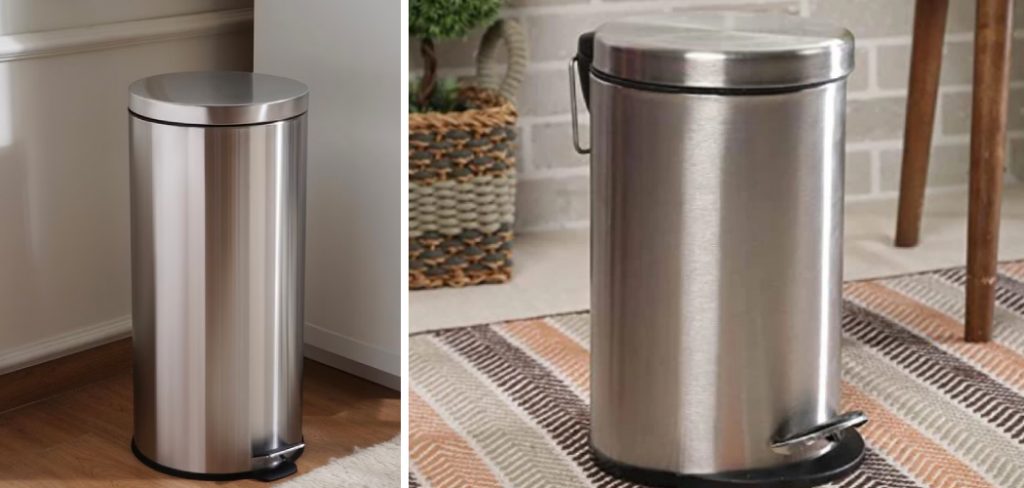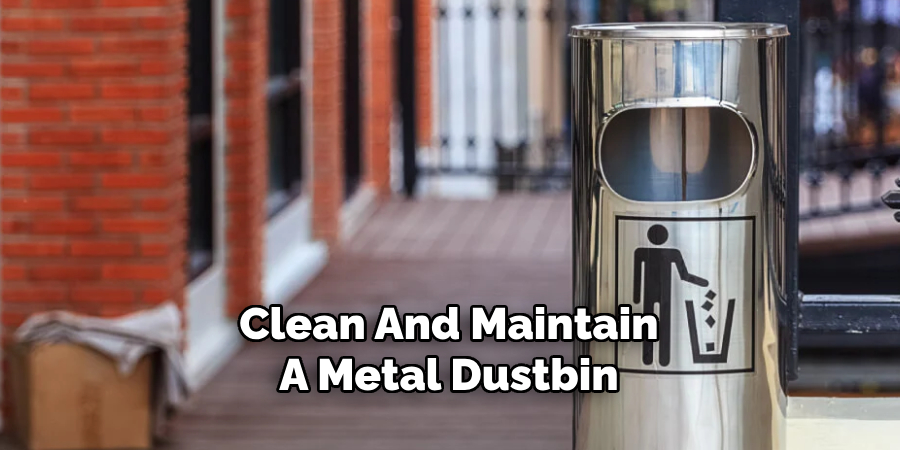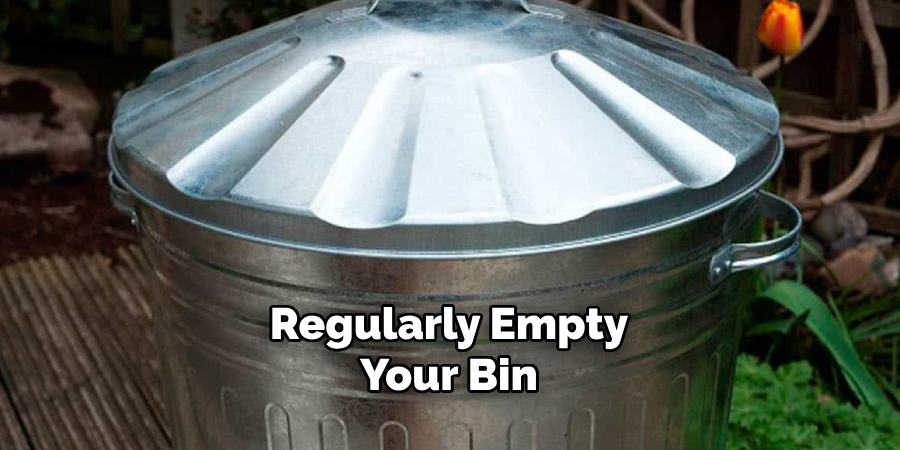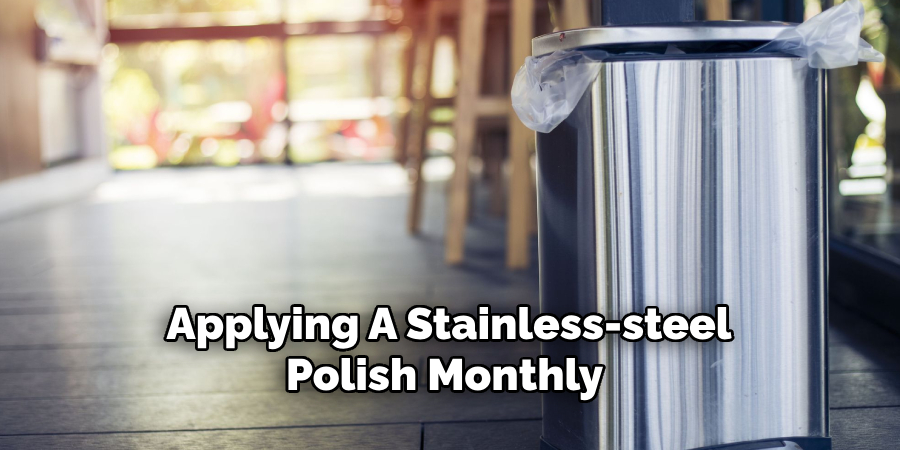Maintaining cleanliness and hygiene in metal dustbins is crucial to ensure a healthy and pleasant environment. Over time, metal dustbins can accumulate grime, bacteria, and unpleasant odors if not properly cared for. A hygienic dustbin not only helps in preventing the spread of germs but also keeps pests at bay and prolongs the life of the dustbin. This guide will provide you with effective steps and tips to know how to make metal dustbin hygienic, ensuring it remains an asset to your home or facility rather than a potential health hazard.

Importance of Maintaining a Hygienic Metal Dustbin
Maintaining a hygienic metal dustbin is essential for several reasons. Firstly, it plays a critical role in reducing the spread of diseases and infections. Dustbins can be a breeding ground for harmful bacteria and viruses if not cleaned regularly. By keeping them hygienic, you minimize the risk of these pathogens contaminating your environment. Secondly, a clean dustbin helps to maintain a fresh and odor-free atmosphere, which is particularly important in indoor settings.
Unpleasant odors not only cause discomfort but can also attract pests such as insects and rodents. Lastly, regular maintenance of your metal dustbin extends its lifespan, saving you the cost and inconvenience of frequent replacements. By investing time in its upkeep, you ensure that it remains both functional and aesthetically pleasing, contributing to a healthier and more pleasant living or working space.
Why Hygiene Is Crucial for Metal Dustbins
Hygiene is crucial for metal dustbins because they are often exposed to a variety of waste materials, including food scraps, plastic, paper, and other organic substances. These materials decompose over time, creating an environment where bacteria and germs can thrive. If dustbins are not cleaned regularly, the accumulation of these pathogens poses a significant health risk to humans and animals, potentially leading to illnesses and infections. Moreover,
the presence of waste can emit foul odors, which degrade the surrounding air quality and make areas uncomfortable for occupants. This can be particularly concerning in workplaces and homes where cleanliness is a priority. Additionally, hygienic practices help in deterring pests such as rats, flies, and cockroaches, which are attracted to organic waste and can further spread diseases. By maintaining high levels of hygiene, metal dustbins can function effectively as essential tools in waste management, contributing to the overall cleanliness and health of any environment.
Materials and Tools Needed
To effectively clean and maintain a metal dustbin, you will need a variety of materials and tools to ensure it remains hygienic:

- Rubber Gloves: Essential for protecting your hands from dirt and harmful chemicals during the cleaning process.
- Bristle Brush or Scrub Pad: Useful for scrubbing away grime and debris from the interior and exterior surfaces of the dustbin.
- Mild Detergent or Disinfectant: A cleaning agent to help eliminate bacteria and neutralize odors.
- Water Hose or Bucket: Necessary for rinsing the dustbin thoroughly after scrubbing.
- Baking Soda: A natural deodorizer that can be sprinkled in the dustbin to help absorb and eliminate odors.
- White Vinegar: A natural cleaning agent and disinfectant that can be used in conjunction with baking soda for stubborn spots.
- Trash Bags: To line the dustbin and make it easier to remove waste without leaving residue.
- Cleaning Cloths or Towels: For drying the dustbin thoroughly after cleaning, preventing moisture build-up that can harbor bacteria.
Equipped with these materials and tools, you can undertake regular cleaning and maintenance of your metal dustbin, ensuring it remains hygienic and functions effectively.
10 Effective Methods How to Make Metal Dustbin Hygienic
1. Line Your Bin with Durable Trash Bags
Using a high-quality trash bag as a liner creates a barrier between waste and the metal surface of your bin. This prevents leaks and stains, making it easier to maintain cleanliness. Whenever you’re replacing the liner, check for any residue at the bottom and clean it promptly with a disinfectant spray.
2. Regularly Empty Your Bin
Overflowing bins not only invite pests but also make cleaning more difficult. Empty your dustbin frequently—preferably before it’s completely full—to reduce the risk of spills and unpleasant odors. A regular schedule helps prevent waste from sticking to the walls of the bin.

3. Wash and Scrub Weekly
Wash your metal dustbin at least once a week with warm soapy water and a bristle brush. Use a biodegradable soap for eco-friendly maintenance. Pay attention to corners and seams where dirt can accumulate. Rinse thoroughly and air-dry under the sun for natural sanitization.
4. Use Baking Soda to Absorb Odor
Sprinkle a layer of baking soda at the bottom of your bin before adding a new liner. Known for its odor-neutralizing properties, baking soda absorbs any unpleasant smell and keeps your dustbin fresh. Replace the baking soda every time you empty the bin.
5. Employ Vinegar and Lemon for Natural Disinfection
Mix equal parts of white vinegar and water into a spray bottle, then add fresh lemon juice. This natural solution works wonders as an antibacterial cleaner. Spray generously on the inside and outside of your bin, leave it for 15 minutes, and wipe clean with a cloth.
6. Opt for a Removable Inner Bucket
If your metal dustbin comes with a removable inner bucket, take advantage of it. The inner bucket can be easier to clean thoroughly and shields the metal exterior from prolonged contact with waste. Simply clean it with soap and water for quick maintenance.
7. Invest in a Lid that Fits Well
Ensure your metal dustbin has a tight-fitting lid to lock in odors and keep pests out. If your bin’s lid design causes gaps, you can add a rubber seal to improve coverage. A well-sealed bin also reduces exposure to bacteria.
8. Add Deodorizer Packets or Charcoal
Charcoal or eco-friendly deodorizer packets are highly effective at absorbing moisture and odors inside the bin. Attach these directly to the underside of the lid or place them at the bottom to keep your dustbin smelling clean.
9. Handle Spills Immediately
If spills occur inside your dustbin, address them promptly to avoid sticky residue that can attract bugs. Use a damp cloth with a bit of dish soap to clean the area, then follow up with an antibacterial spray to disinfect.
10. Keep the Exterior Shiny with Polish
Maintain the metal’s surface by applying a stainless-steel polish monthly. This prevents rust and fingerprint marks and adds an extra layer of protection against bacterial growth. If you prefer a DIY solution, rub olive oil with a soft cloth to get a similar effect.

Wrapping It Up
A hygienic dustbin isn’t just about reducing unpleasant smells—it’s key to cultivating a cleaner and healthier environment for your home or business. By adopting these practices, you’ll extend the lifespan of your metal bin while making waste management a breeze.
Things to Consider When Maintaining Your Metal Dustbin
When it comes to maintaining your metal dustbin, there are several important factors to keep in mind. First, consider the placement of your dustbin. Keeping it in a shaded area can help reduce exposure to sunlight, which may cause fading or deterioration of the metal over time. Next, think about the type of waste you are disposing of and ensure it aligns with the capabilities of a metal dustbin, as certain materials like acidic substances can corrode metal surfaces. Additionally,
consider the frequency of cleaning routines. It’s essential to establish a cleaning schedule that matches the usage rate of the dustbin to maintain hygiene effectively. Finally, be mindful of using environmentally friendly cleaning products whenever possible, thus minimizing your environmental footprint while maintaining cleanliness. These considerations will help ensure your metal dustbin remains functional and hygienic for the long term.
Common Mistakes to Avoid
While maintaining a metal dustbin, it’s essential to be aware of potential pitfalls that can compromise its hygiene and longevity. One common mistake is neglecting regular cleaning, which leads to the accumulation of dirt and bacteria. Avoid overfilling the dustbin, as this can cause spills and leftover residue, making cleaning more challenging. It’s also important not to use corrosive cleaners or abrasive tools that can damage the metal surface.
Ensure trash bags are securely placed; otherwise, leaks can occur, causing unpleasant odors. Lastly, don’t forget to address lid malfunctions, as a proper seal is crucial for preventing pests and maintaining a clean environment. Rectifying these mistakes will contribute to a cleaner and more durable dustbin.

Conclusion
Maintaining a metal dustbin entails consistent care and attention to detail. By implementing a combination of regular cleaning practices and using appropriate cleaning solutions, you can ensure its longevity and hygiene. Avoiding common mistakes and making thoughtful decisions about placement and waste type are key factors in preserving the dustbin’s condition. A well-maintained metal dustbin not only helps in managing waste more effectively but also contributes to a healthier and more pleasant environment. Thanks for reading, and we hope this has given you some inspiration on how to make metal dustbin hygienic!
you can also check it out Repair Cracked Cast Iron
Edmund Sumlin is a skilled author for Metal Fixes, bringing 6 years of expertise in crafting a wide range of metal fixtures. With a strong background in metalwork, Edmund’s knowledge spans various types of fixtures, from decorative pieces to functional hardware, blending precision with creativity. His passion for metalworking and design has made him a trusted resource in the industry.
Professional Focus:
- Expert in Metal Fixtures : Edmund aesthetic specializes in creating durable and innovative metal fixtures, offering both appeal and functionality. His work reflects a deep understanding of metalworking techniques and materials.
- Sustainability Advocate : He is dedicated to using sustainable practices, ensuring that every fixture is crafted with eco-friendly methods while maintaining high-quality standards.
In his writing for Metal Fixes, Edmund provides valuable insights into the latest trends, techniques, and practical advice for those passionate about metal fixtures, whether they are professionals or DIY enthusiasts. His focus on combining artistry with engineering helps others discover the true potential of metal in design.


